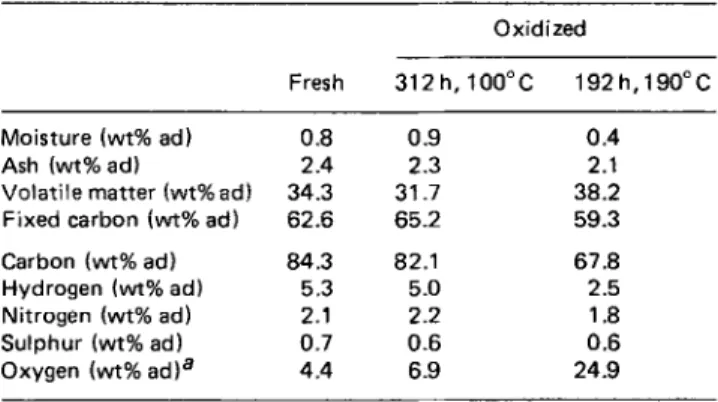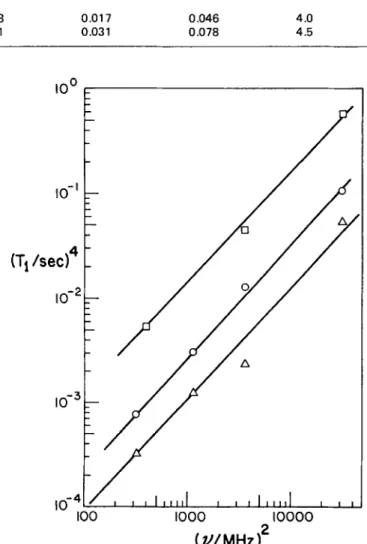Publisher’s version / Version de l'éditeur:
Fuel, 63, 4, pp. 522-524, 1984-04
READ THESE TERMS AND CONDITIONS CAREFULLY BEFORE USING THIS WEBSITE. https://nrc-publications.canada.ca/eng/copyright
Vous avez des questions? Nous pouvons vous aider. Pour communiquer directement avec un auteur, consultez la première page de la revue dans laquelle son article a été publié afin de trouver ses coordonnées. Si vous n’arrivez pas à les repérer, communiquez avec nous à PublicationsArchive-ArchivesPublications@nrc-cnrc.gc.ca.
Questions? Contact the NRC Publications Archive team at
PublicationsArchive-ArchivesPublications@nrc-cnrc.gc.ca. If you wish to email the authors directly, please see the first page of the publication for their contact information.
NRC Publications Archive
Archives des publications du CNRC
This publication could be one of several versions: author’s original, accepted manuscript or the publisher’s version. / La version de cette publication peut être l’une des suivantes : la version prépublication de l’auteur, la version acceptée du manuscrit ou la version de l’éditeur.
For the publisher’s version, please access the DOI link below./ Pour consulter la version de l’éditeur, utilisez le lien DOI ci-dessous.
https://doi.org/10.1016/0016-2361(84)90290-4
Access and use of this website and the material on it are subject to the Terms and Conditions set forth at
¹H n.m.r. relaxation in bituminous coal and semicoke
Ripmeester, John A.; Couture, Christiane; MacPhee, J. Anthony; Nandi,
Biswanath N.
https://publications-cnrc.canada.ca/fra/droits
L’accès à ce site Web et l’utilisation de son contenu sont assujettis aux conditions présentées dans le site LISEZ CES CONDITIONS ATTENTIVEMENT AVANT D’UTILISER CE SITE WEB.
NRC Publications Record / Notice d'Archives des publications de CNRC:
https://nrc-publications.canada.ca/eng/view/object/?id=f0b826aa-2125-445e-b20d-38432052bb48
https://publications-cnrc.canada.ca/fra/voir/objet/?id=f0b826aa-2125-445e-b20d-38432052bb48
1H n.m.r.
relaxation
in bituminous
coal and
semicoke
John A. Ripmeester,
Christiane
Couture,
J. Anthony
MacPhee*
and
Biswanath
N. Nandi*
Division of Chemistry, National Research Council of Canada, Ottawa, Ontario, KlA OR9, Canada
* Energy Research Laboratories, Canada Centre for Mineral and Energy Technology, Department of Energy, Mines and Resources, 555 Booth Street, Ottawa, Ontario, KlA OGI, Canada
(Received 76 December 7982; revised 26 July 1983)
Temperature and frequency-dependent proton relaxation measurements, in conjunction with spin concentrations determined by e.s.r., have shown that for fresh and oxidized coal the relaxation mechanism involves spin-diffusion to paramagnetic centres and to rotating methyl groups on alkyl chains. 1H relaxation in semicokes is more complex; probably both direct relaxation to paramagnetic centres as well as spin-diffusion contribute.
(Keywords: coal; semicoke; n.m.r.)
Recently there has been a great increase in interest in the
n.m.r. properties of coal and related materials’~‘. ‘H
n.m.r. relaxation times of different ranks of coal have been
found to range over more than an order of magnitude’,‘.
Although some attempts have been made to understand
the relaxation mechanism, empirical relationships are
frequently explored4v5.
For high rank coals
(~886-95 wt% carbon daf), 7”
increases with increasing radical content’ *2 and it has
been proposed that the relaxation mechanism involves
spin-diffusion to paramagnetic centres’. However, this
does not explain the trend for lower rank coals, for which
T1 decreases with decreasing radical content.
Also,
possible contributions from other relaxation mechanisms
have not been explored.
In order to elucidate ‘H relaxation mechanisms in coal
further, the frequency and temperature dependences of
the spin-lattice
relaxation
time of a high volatile
bituminous coal have been examined in the present work,
and the unpaired spin concentration has been determined.
Fresh and oxidized samples of both coal and semicoke
were studied.
EXPERIMENTAL
Tl was measured at 18,34,60 and 180 MHz on Bruker
SXP and CXP pulsed n.m.r. spectrometers by means of
90”-t-90” pulse sequences. Temperature
variation was
accomplished in the cryostat described previously6. ‘H
linewidths at room temperature were measured at 180
MHz from the Fourier transformed free induction decay.
The analyses of the high volatile bituminous Devco coal
used in these experiments are summarized in Table 1. The
samples were sealed in glass tubes under vacuum after
pumping for several hours. Spin concentrations
were
measured at 9.5 GHz on a Varian E-3 e.s.r. spectrometer
using diphenyl picryl hydrazyl (DPPH) as a calibrant.
0016-2361~84/040522~3$3.00
@ 1984 Butterworth & Co. (Publishers) Ltd
522
FUEL, 1984, Vol 63, AprilTable 1 Analyses of coal samples
Oxidized
Fresh 312 h, 100°C 192h,190”C
Moisture (wt% ad) 0.8 0.9 0.4 Ash (wt% ad1 2.4 2.3 2.1 Volatile matter (wt%ad) 34.3 31.7 38.2 Fixed carbon (wt% ad) 62.6 65.2 59.3
Carbon (wt% ad) 84.3 82.1 67.8 Hydrogen (wt% ad) 5.3 5.0 2.5 Nitrogen (wt% ad) 2.1 2.2 1.8 Sulphur (wt% ad) 0.7 0.6 0.6 Oxygen (wt% ad)a 4.4 6.9 24.9 a By difference
RESULTS AND DISCUSSION
For each coal sample, the magnetization decay curves
were slightly
non-exponential.
The
time constant
governing the decay at long times was taken to be the
characteristic
Tl value. Relaxation times at different
frequencies are summarized in
zyxwvutsrqponmlkjihgfedcbaZYXWVUTSRQPONMLKJIHGFEDCBA
Table 2.The temperature behaviour of
Tlfor the coal samples is
shown in
Figure I.For each sample there is a shallow
minimum in
T,, at 143 Kfor the 18 MHz measurements
and at 167 K for the 60 MHz measurements.
Line shapes were approximately Gaussian and showed
no evidence of two-component
behaviour. The =8G
linewidth leads to a second moment of x 11 G2, indicating
that extensive molecular motion does not take place.
The relaxation behaviour of the fresh coal and lightly
oxidized coal is much the same,
Tlvalues for the oxidized
sample being slightly shorter at all temperatures
(Figure I).For bituminous coals containing x86 wt% carbon it
has been suggested that relaxation is due to spin-diffusion
to paramagnetic
centres.
Spin concentrations,
as
‘H n.m.r. relaxation in coal and semicoke: J. A. Ripmeester et al. Table 2 Summary of relaxation times and linewidths at room temperature
- Linewidth Sample (gauss) 18 MHz 34 MHz Coal Fresh 8.0 0.167 0.236 Oxidized 312 h, 100°C 8.1 0.134 0.187 Oxidized 192 h, 190°C 6.1 0.27 - Semicoke Fresh 8.1 0.022 0.018 Oxidized 7.8 0.033 0.031 T1 kl No.of spins 60 MHz 180 MHz 10’9g-1 0.337 0.573 0.88 0.219 0.486 1.5 0.46 0.873 0.50 0.017 0.046 4.0 0.031 0.078 4.5 0.4 t Coal oxidized 192 hrs at 190°C 2 4 6 8 IO 12
1000 K/T
Figure 1 Log T, plotted against reciprocal temperature for fresh and oxidized coal samples at different frequencies. A, Fresh coal; 0, oxidized coal
determined by e.s.r.
zyxwvutsrqponmlkjihgfedcbaZYXWVUTSRQPONMLKJIHGFEDCBA
(Table 2), show that the unpaired-spincontent increased on mild oxidation but decreased in the case of severe oxidation. The ‘H spin-lattice relaxation times at different frequencies decreased on mild oxidation and increased on severe oxidation, as shown in Table 2 and also in the log-log plot of T: against II? (Figure 2).
The fact that this plot gives reasonably straight lines for the three samples confirms that the main relaxation mechanism involves spin-diffusion to paramagnetic ce- ntres. Hence the proton Tl values should vary inversely with unpaired spin content, as is indeed the case. Such a relaxation mechanism also explains the non-exponential initial magnetization decay 8.
On the other hand, the minimum observed in the plot of log Tl against l/T and the frequency dependence of the Tl minimum is reminiscent of a classical BPP Tl minimum due to molecular motion’. At the relatively low temperatures of the Tl measurements, the only motion rapid enough to give a Tl minimum in a complex material such as coal is methyl group rotation. The usual criteria for T, minima due to motions cannot be expected to apply, as methyl rotation is not the exclusive relaxation
IO0
W/MHz)*
Figure 2 Log-log plot of the fourth power of relaxation time against frequency squared for fresh and oxidized coal samples. 0, Fresh coal; A, coal oxidized 312 h at 100°C; 0, coal oxidized 192 h at 190°C
mechanism. Also, because of the non-crystalline nature of coal, there must be a distribution of motional para- meters”, and the usual dependence of Tl on the square of the frequency at low temperatures and the frequency independence of Tl above the Tl minimum can no longer hold”. However, at the Tl minimum the relation or, ~0.62 is valid and the frequency dependence of the T, minimum can be used to estimate an activation energy for the motion from
E = R ln(44
= l/T,- l/T, (1)
where w,, ot, = the radio frequencies; and T, and Tb = the temperatures of the corresponding relaxation minima. The above equation applied to the data in Figure 1 yields an activation energy of 11.3 kJ mol-‘, a reasonable value for methyl groups terminating alkyl chains”. Methyl groups directly attached to aromatic rings have much lower activation energies12,r3.
H n.m.r. relaxation in coal and semicoke: J. A. Ripmeester et al.
A rough estimate can be made of the number of methyl groups required to give a minimum of the observed depth. In the presence of spin-diffusion to methyl groups, 7” is given by
T;‘=f,,T,-,‘,+(l-f,,)T;,‘, (2)
where fMe = the fraction of protons in methyl groups; T Me is the relaxation time for an isolated methyl group; and TiN is the relaxation time of the other protons, If we estimate Tr., to be 400 ms (Figure I) and calculate the minimum T,Me to be 33 ms from the modified BPP
equationi4, zyxwvutsrqponmlkjihgfedcbaZYXWVUTSRQPONMLKJIHGFEDCBA
fMe
is found to be 0.063. Because a distri- bution in motional parameters makes relaxation at theminimum less effective”, this value of
zyxwvutsrqponmlkjihgfedcbaZYXWVUTSRQPONMLKJIHGFEDCBA
fMe
represents a lower limit. For the heavily oxidized coal, the same T1minimum due to methyl group rotation is still evident, although at higher temperatures a new relaxation process sets in. This is in agreement with the fact that the coal structure is altered considerably during the oxidation process. The smaller proton linewidth as compared with the linewidth for the other two coal samples, as well as the appearance of a new relaxation mechanism, suggest
increased molecular mobility, perhaps due to
depolymerization.
Whereas the details of the variation in relaxation time with temperature apparently reflect molecular motion, the gross Tr values reflect changes in radical content. Mild oxidation increases the radical content, but more severe oxidation causes a subsequent decrease. This is in agreement with a recent n.m.r. and e.s.r. study” of the radical content as a function of oxidation for several coking coals.
As is evident in Table 2, the ‘H relaxation time in the semicokes is an order of magnitude shorter than in the coals. An attempt to measure TI at lower temperatures
showed that the magnetization decay curves became
extremely non-exponential. Since a lower proton density is to be expected as a consequence of the absence of volatiles, it is perhaps surprising that the proton linewidth is unaltered from that of fresh coal.
The frequency dependence of T, at room temperature for the semicokes does not show a simple trend and evidently does not fit a plot of T: against 02. If extensive aromatization has taken place during the coking process, considerable delocalization of any unpaired spins present in the sample may be expected. Perhaps in addition to spin-diffusion to radical centres, many protons are relaxed directly by interactions with unpaired spins. REFERENCES 1 2 3 4 5 6 7 8 9 10 11 12 13 14 15
Yokono, T. and Sanada, Y. Fuel 1978,57,334
Gerstein, B. C., Chow, C., Pembleton, R. G. and Wilson, R. C. J.
Phy s. Chem. 1977,81, 565
Yokono, T., Miyazawa, K., Sanada, Y. and Marsh, H. Fuel 1979, 58,896
Chow, C. K. Fuel, 1981,60, 749
Miyazawa, K., Yokono, T., Sanada, Y. and Marsh, H. Fuel 1979, 58,691
Garg, S. K., Davidson, D. W. and Ripmeester, J. A. J. Magn.
Reson. 1974,
zyxwvutsrqponmlkjihgfedcbaZYXWVUTSRQPONMLKJIHGFEDCBA
15, 295 Abragam, A. ‘The Principles of Nuclear Magnetism’, OxfordUniversity Press, 1961, p. 388
Haupt, J. and Miiller-Wammth, W. 2. Naturforsch. 1967, 22a, 643
Bloembergen, N., Purcell, E. M. and Pound, R. V. Phys. Rev.
1948, 73, 679
Connor, T. M. Trans. Farad. Sot. 1964,60, 1574
Anderson, J. E. and Slichter, W. P. J. Phy s. Chem. 1965,69,3099 Allen, P. S. and Cowking, A. J. Chem. Phys. 1968, 49, 789 Von Schlitz, J. U., Guttler, W. and Wolf, H. C. Z. Nnturforsch. 1973,2&a, 69
O’Reilly, D. E. and Tsang, T. Phys. Rev. 1967, 157,417 Yokono, T., Miyazawa, K., Sanada, Y. and Marsh, H. Fuel 1981, 60, 598

